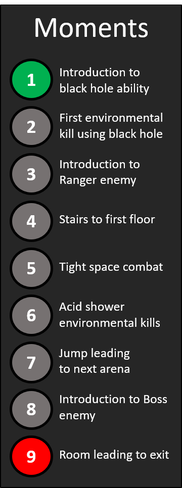|
Project Black Hole is a first person twitch shooter heavily inspired by DOOM. In the game, the player fights his way through a toxic chemicals lab overrun by monsters. The player has a set of powerful weaponry with gravity manipulating abilities to his disposal. These can be used to group monsters up, or to throw them into a hazard for an environmental kill.
My tasks on this project included:
|
|
PROCESS
Playing to the strengths of the game
For every project, I make sure to conduct research first before delving into actual development. It is important to get to know the game you are designing for, and playing the game; experiencing it for yourself, is the best way of doing that. For this project, I was involved in the conception process which gave me a head start when it came to collecting game metrics as I had a hand in balancing them.
When designing a level, it is important to play to the strengths of your game; to create gameplay moments which support and elevate the mechanics of the game. For this game, the fun mainly comes from the gunplay: All weapons feel exceptionally powerful and diverse. The biggest fun-factor is that the player can shoot a black hole when the energy meter is filled up all the way, which can be done by damaging enemies. A black hole groups enemies up, and lets them dangle in the air hopelessly until the black hole vanishes.
When designing a level, it is important to play to the strengths of your game; to create gameplay moments which support and elevate the mechanics of the game. For this game, the fun mainly comes from the gunplay: All weapons feel exceptionally powerful and diverse. The biggest fun-factor is that the player can shoot a black hole when the energy meter is filled up all the way, which can be done by damaging enemies. A black hole groups enemies up, and lets them dangle in the air hopelessly until the black hole vanishes.
The level design process
|
By shooting a black hole in the right spot, the player can throw enemies off the map to get environmental kills. I made sure to come up with as many scenarios for this as possible, and sketched them out.
After this, I whiteboxed these moments in a gym level to test their viability. The moments with potential were kept, and the moments which did not work too well were either revised or scrapped. |
|
The next step was to put all of these moments in order, sorted on difficulty, so the game would become more and more difficult the further the player progresses. To do this, I created a node map. For encounters early on in the game, I made sure to have them be intense without being mechanically demanding.
|
Improving the level based on feedback
After implementing all gameplay moments, it was time to playtest the level. I used feedback from both internal playtesting sessions, where I made notes while players played, and from external playtests using a form. I put the feedback into a spreadsheet to analyze it. This made it easy to draw conclusions from the feedback, and I used this to adjust the layout of the level.
This iteration cycle was repeated as many times as time allowed for, and in the end it led to quite a polished level, ready for an art pass.
Below, a comparison between the first draft, and the final whitebox can be found.
Below, a comparison between the first draft, and the final whitebox can be found.
Get In Touch
As a developer and an individual I like to be challenged and am always on the lookout for new ways to provide players with unforgettable and meaningful experiences. If you are interested in how I can help you out, please do not hesitate to contact me;
© Martijn de Bie
All content and trademarks property of their respective owners.
All content and trademarks property of their respective owners.








